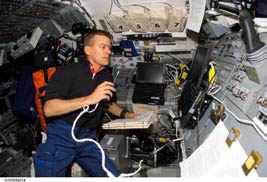2.5 DEBRIS STRIKE ANALYSIS AND REQUESTS FOR IMAGERY
2.5 Debris Strike Analysis and Requests for Imagery
破片の衝突に関する分析と撮影の要請
破片の衝突に関する分析と撮影の要請
As is done after every launch, within two hours of the lift-off the Intercenter Photo Working Group examined video from tracking cameras. An initial review did not reveal any unusual events. The next day, when the Intercenter Photo Working Group personnel received much higher resolution film that had been processed overnight, they noticed a debris strike at 81.9 seconds after launch.
いつものように、打上げの2時間後にはセンター内の画像分析ワーキンググループが追跡カメラの映像を調査しました。最初のレビューでは、異常は発見されませんでした。翌日、画像分析グループのメンバーは、一晩かけて処理されたより解像度の高いフィルムを受け取り、打上げ後81.9秒後に破片が衝突していることを見つけました。
A large object from the left bipod area of the External Tank struck the Orbiter, apparently impacting the underside of the left wing near RCC panels 5 through 9. The objects large size and the apparent momentum transfer concerned Inter-center Photo Working Group personnel, who were worried that Columbia had sustained damage not detectable in the limited number of views their tracking cameras captured. This concern led the Intercenter Photo Working Group Chair to request, in anticipation of analysts needs, that a high-resolution image of the Orbiter on-orbit be obtained by the Department of Defense. By the Boards count, this would be the first of three distinct requests to image Columbiaon-orbit. The exact chain of events and circumstances sur-rounding the movement of each of these requests through Shuttle Program Management, as well as the ultimate denial of these requests, is a topic of Chapter *6.
外部燃料タンクの左のバイポット部から脱落した大きな物体が、オービターに衝突していました。どうやら、衝突は左翼RCCパネルの5番から9番の下部のようでした。破片のサイズが大きかったことと落下の運動量の予測から、画像分析ワーキンググループの職員は、コロンビアに損傷があった場合、限られた数しかなかった追跡カメラでは捉えられていない可能性があるという懸念を示しました。これを受けて、画像分析ワーキンググループの議長は、アナリストの予測に必要との判断から、軌道上のシャトルの高解像度の画像を国防省から得ることを要請しました。
After discovering the strike, the Intercenter Photo Working Group prepared a report with a video clip of the impact and sent it to the Mission Management Team, the Mission Evalu-ation Room, and engineers at United Space Alliance and Boeing. In accordance with NASA guidelines, these contrac-tor and NASA engineers began an assessment of potential impact damage to Columbias left wing, and soon formed a Debris Assessment Team to conduct a formal review.
衝突が発見された後、画像分析ワーキンググループはレポートと衝突を捉えたビデオクリップを、ミッションマネジメントチーム、ミッション評価室、そしてボーイングとユナイテッドスペースアライアンスのエンジニアたちに送付しました。NASAのガイドラインに従い、これらの協力会社とNASAのエンジニアはコロンビアの左翼の損傷の可能性について検討をはじめ、すぐに破片評価チームが正式なレビューのために組織されました。
The first formal Debris Assessment Team meeting was held on January 21, five days into the mission. It ended with the highest-ranking NASA engineer on the team agreeing to bring the teams request for imaging of the wing on-orbit, which would provide better information on which to base their analysis, to the Johnson Space Center Engineering Management Directorate, with the expectation the request would go forward to Space Shuttle Program managers. De-bris Assessment Team members subsequently learned that these managers declined to image Columbia.
最初の公式な破片評価チームの会議はミッション開始から5日後の1月21日に開かれました。会議はチームに属するNASAの最高位のエンジニア達は軌道上のシャトルの翼の撮影を依頼するという合意に達しました。この撮影によって、彼らが行う分析の土台となるような、より質の高い情報が得られることが期待されたのです。依頼はジョンソン宇宙センターのマネジメント層に対して行われ、スペースシャトルプログラムのマネージャーへ転送されることが望まれていました。しかし、後に破片評価チームのメンバーは、コロンビアの撮影をこれらのマネージャーが断ったことを知らされたのです。
Without on-orbit pictures of Columbia, the Debris Assess-ment Team was restricted to using a mathematical modeling tool called Crater to assess damage, although it had not been designed with this type of impact in mind. Team members concluded over the next six days that some localized heating damage would most likely occur during re-entry, but they could not definitively state that structural damage would result. On January 24, the Debris Assessment Team made a presentation of these results to the Mission Evaluation Room, whose manager gave a verbal summary (with no data) of that presentation to the Mission Management Team the same day. The Mission Management Team declared the debris strike a "turnaround" issue and did not pursue a request for imagery.
軌道上でのコロンビアの画像が得られなかったため、破片調査チームは「クレーター」と呼ばれる数学的モデルを構築するツールだけで損傷の検証を行いましたが、このツールはこのタイプの衝突を念頭においてデザインされたものではありませんでした。チームのメンバーは、6日後に限定的な熱による損傷が起きる可能性があるという結論を出しましたが、構造的な損傷が起きる可能性については明言しませんでした。1月24日、破片調査チームはこれらの結果をミッション評価ルームに対して発表しました。同日、評価ルームのマネージャーはこのプレゼンテーションの概略をミッションマネジメントチームに口頭で伝えました(データは示されませんでした)。ミッションマネジメントチームは破片の衝突は(シャトルが地上に戻ってから整備が終わるまでの)「ターンアラウンド」の問題であるとし、軌道上のシャトルの撮影を追求しませんでした。
Even after the Debris Assessment Teams conclusion had been reported to the Mission Management Team, engineers throughout NASA and Mission Control continued to ex-change e-mails and discuss possible damage. These messag-es and discussions were generally sent only to people within the senders area of expertise and level of seniority.
破片調査チームの結論がミッションマネジメントチームに伝えられた後も、エンジニアはNASAを通じてミッションコントロールとeメールのやり取りを続け、損傷の可能性について議論していました。これらのメッセージと議論は、その殆どが専門技術分野のベテランのエンジニア達によってなされていました。

William McCool talks to Mission Control from the aft flight deck of Columbia during STS-107.
ウィリアムマックールがSTS-107の後部フライトデッキで、
ミッションコントロールと通信を行っている。
ミッションコントロールと通信を行っている。